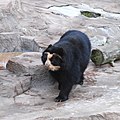Spectacled bear
The spectacled bear (Tremarctos ornatus), also known as the Andean bear is the last of the lineage of short-faced bears. Locally, it is also called ukuku, jukumari or ukumari. The other short-faced bears are now extinct. They lived during middle to late Pleistocene age.[1][2]
| Spectacled bear | |
|---|---|

| |
| A spectacled bear in Sorocaba zoo, Brazil. | |
| Conservation status | |
| Scientific classification | |
| Kingdom: | |
| Class: | |
| Order: | |
| Family: | |
| Genus: | Tremarctos
|
| Binomial name | |
| Tremarctos ornatus | |
The spectacled bear is a relatively small species of bear native to South America. It has black fur with a distinctive beige-coloured marking across its face and upper chest. Males are 33% larger than females.[3] Males can weigh 130 – 200 kilograms (286 – 440 lb), and females 35 – 60 kilograms (77 – 132 lb). They are found in several areas of northern and western South America, including western Venezuela, Colombia, Ecuador, Peru, western Bolivia, northwestern Argentina, and eastern Panama.[4] Spectacled bears are the only surviving types of bear native to South America, and the only surviving member of the subfamily Tremarctinae. Their survival has depended mostly on their ability to climb even the highest trees of the Andes.
Spectacled Bear Media
Spectacled bear at Tennoji Zoo in Osaka, Japan
Spectacled bear at the Houston Zoo in Texas, USA
References
| Wikispecies has information on: Tremarctos ornatus. |
- ↑ Grizzly Bear.org: Spectacled Bear
- ↑ Bear Planet
- ↑ Brown, Gary (1996). Great Bear Almanac. p. 340. ISBN 1-55821-474-7.
- ↑ Bunnell, Fred (1984). Macdonald, D. (ed.). The Encyclopedia of Mammals. New York: Facts on File. pp. 96. ISBN 0-87196-871-1.








